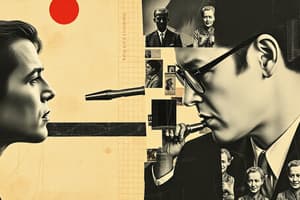Podcast
Questions and Answers
Which of the following describes Monroe's Motivated Sequence?
Which of the following describes Monroe's Motivated Sequence?
- A theory explaining relationship formation.
- A method used to analyze nonverbal communication.
- A structured approach to designing persuasive speeches. (correct)
- A framework for understanding cultural diversity.
What is a key component of selective perception?
What is a key component of selective perception?
- Automatically accepting all new information without critique.
- The ability to remember all experiences accurately.
- A technique for effective group communication.
- The process of filtering information based on personal biases. (correct)
Which characteristic is essential for cultural competence?
Which characteristic is essential for cultural competence?
- Promoting cultural superiority over others.
- Avoiding contact with different cultures.
- Strict adherence to one's own cultural practices.
- A willingness to adapt and understand diverse cultural perspectives. (correct)
In small group communication, what is an essential role of a leader?
In small group communication, what is an essential role of a leader?
What does the Social Exchange Theory primarily focus on?
What does the Social Exchange Theory primarily focus on?
Flashcards
Persuasion
Persuasion
The process of influencing others' beliefs, attitudes, or behaviors.
Culture
Culture
Groups of individuals who share common beliefs, values, and behaviors.
Interpersonal Communication
Interpersonal Communication
Communication that occurs between two people who have a relationship.
Perception Checking
Perception Checking
Signup and view all the flashcards
Organizational Communication
Organizational Communication
Signup and view all the flashcards
Study Notes
Persuasion
- Persuasion involves influencing others' beliefs, attitudes, or behaviors.
- Different types of persuasive speeches exist, catering to different aims.
- Various argument types are used depending on the persuasive approach.
- Monroe's Motivated Sequence is a method for structured persuasive presentations.
Hearing vs. Listening
- Hearing is a physiological process of perceiving sound.
- Listening is the active cognitive process of interpreting meaning.
- Different listening types exist for different contexts, like empathetic listening or critical listening.
- HURIER model is a listening framework (Hearing, Understanding, Remembering, Interpreting, Evaluating, Responding).
Perception & Perceptual Biases
- Perceptions shape how we interpret the world.
- Perceptual biases influence our perceptions, often unconsciously.
- Selective attention focuses on certain stimuli while ignoring others.
- Selective exposure means seeking information confirming existing beliefs.
- The "filter bubble" isolates individuals from diverse perspectives.
- Selective perception and memory distort information to fit personal views.
- Schemas are mental frameworks that organize related information. Different types of schemas exist.
- Self-concept is the perception of oneself.
Small Group Communication
- Small group communication happens among a few people with a common goal.
- Groups go through developmental stages, from forming to performing.
- Different group roles (task roles, maintenance roles, and disruptive roles) impact the group.
- Effective leadership in small groups influences group dynamics.
- Conflict management techniques are important for productive group interaction.
Culture & Diversity
- Culture consists of shared values, beliefs, and behaviors.
- Cultural rituals are symbolic practices within a culture.
- Cultural characteristics encompass diverse norms and values.
- Cultural Competence is understanding cultural nuances to communicate effectively.
- Perception-checking is crucial for cross-cultural understanding.
- Diversity encompasses various identities and experiences.
- Communication barriers arise from cultural misunderstandings.
Interpersonal Communication
- Interpersonal communication involves interactions between people.
- Relationship formation through physical and social attraction is crucial.
- Social exchange theory explains relationships based on cost-benefit analyses.
- Social penetration theory describes how relationships develop.
- Personal perspectives and turning points shape relationships.
- Strong relational cultures foster positive and supportive relationships.
Organizational Communication
- Organizational communication occurs within structured environments.
- Formal and informal communication networks exist.
- Various communication channels transmit information.
- Workplace cultures are shaped by artifacts, values, and underlying assumptions.
- Workplace socialization involves understanding and adapting to workplace norms.
New Media
- New media encompasses digital communication technologies.
- New media evolves from oral communication tradition.
- New media characteristics include interactivity and accessibility.
- Theory of self-presentation guides how individuals present themselves online.
- Different approaches are used to present online identity.
Studying That Suits You
Use AI to generate personalized quizzes and flashcards to suit your learning preferences.




